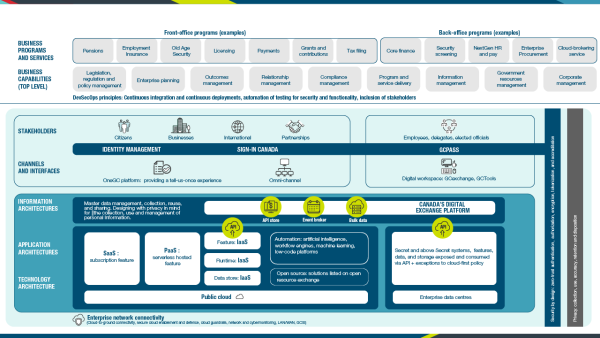Canada, a country once known as a bastion of freedom and human rights on the international stage, is set to roll out a federally mandated framework for a Chinese Communist Party-style digital ID social credit system.
Dubbed “Canada’s Digital Ambition 2022,” a federal government website cites the oft-decried Coronavirus Disease 2022 (COVID-19) freedom of movement-restricting measures and mandates as a foundation for the program’s necessity.
“Since the onset of the COVID-19 pandemic, Canadians have increasingly worked, shopped, learned, and engaged with government online,” it reads.
“Their expectation and need for easy to use, accessible digital options continue to grow, and many public- and private-sector organizations are transforming to use digital technologies to deliver better programs and services.”
MORE ON THE GLOBAL SOCIAL CREDIT ROLLOUT
- Uganda Set to Deploy DNA Recognition ‘Smart Digital’ Biometric ID
- Atlanta Stadium Trials Biometric Facial Recognition Systems
- Greece Moves Towards Social Credit as Digital ID App Replaces Drivers Licenses
- Sri Lanka Introduces Social Credit QR Code Fuel Rationing Amid Economic Collapse
The stated plan is several dozen pages long, winding, winded, jargonized, and repetitive, in addition to being vague on substantive details.
Success
You are now signed up for our newsletter
Success
Check your email to complete sign up
However, what the missive does reveal is a plan to digitize all public-facing and internal government services, such as old age security and the tax department, with an artificial intelligence-powered, cloud-based system.

The development, however, is novel only at the federal government level. Provinces, such as Ontario and Alberta, already have an existing form of digital ID either in the works or rolled out.
In Ontario’s case, its promotional website for the system used verbiage indicating the motive is to revolutionize a social paradigm shift, “Current solutions, like scanning your driver’s licence and sending it by email are inconvenient and insecure.”
It added, “Ontario’s Digital ID will mean more businesses that require customer identification will be able to move their services online.”
The Government of Ontario’s website also cited data from the Digital ID & Authentication Council of Canada, McKinsey Global Institute, and globalist policy facilitator World Economic Forum.
By contrast, in Alberta’s case, the government appears to have created a spartan implementation and a simple way to have Provincial identification cards work online so that citizens can verify their identity with government outlets such as the Canada Revenue Agency’s My Account more easily.
The difference is important, as former Privacy Commissioner Daniel Therrien told the House of Commons in June.
“Digital ID, like all technologies, can be helpful and privacy protective or harmful to privacy depending on how it is designed,” he said according to True North Canada. “It is certainly conceivable that digital ID could enhance the verification process and the authentication process, allowing citizens to have access to services.”
Therrien continued, “It is certainly possible that digital ID would lead to the data being available to many players or actors, corporate or governmental, that should not have access to all of this data, but it doesn’t have to be designed that way.”
The progression certainly has freedom watchers on heightened alert, such as an Aug. 10 article published by legal watchdog Justice Center for Constitutional Freedoms titled Canada’s Road to Beijing: The Digital Threat to the Charter Rights and Freedoms of Canadians.
In an Aug. 11 op-ed published by the JCCF in Life Site News, the organization first summarized the roots of digital ID and social credit, which lie with the system the Chinese Communist Party has used to dominate civilians for more than a decade.
“Digital ID and digital currency technologies are hardly novel, having been extensively developed and implemented in the People’s Republic of China under the Chinese Communist Party (CCP) since 2009,” they stated.
“There, these technologies have armed the CCP to ‘blacklist’ and segregate Chinese (and even Canadian) citizens for criminal behavior, for disseminating controversial beliefs, for holding religious gatherings, for having too many children, and even for purchasing too many video games.”
JCCF President John Carpay told Life Site, “What Canadians need today is not more unmitigated government access to private information but, instead, a renewed commitment to Charter rights and freedoms. We are on the road to Beijing, and Canadians should be apprehensive.”
Carpay added, “Things are moving fast, and Canadians should be very concerned that a free and democratic society is quickly headed towards a society where citizens can be cancelled by the government with the flick of a switch.”
And the JCCF’s chief has a precedent from the Trudeau Liberals to rely on for his statements.
During the Freedom Convoy trucker occupation protests earlier in the year, once the Trudeau administration deployed an unprecedented usage of the Emergencies Act to quash an otherwise peaceful protest, many ordinary citizens who had supported the protests had their bank accounts temporarily frozen.
In another instance, Justice Minister and Attorney General David Lametti, while referring to the Freedom Convoy, threatened “member[s] of a pro-Trump movement” that they ought to be worried about having their bank accounts frozen by the government.
In a televised question and answer session with CTV in February, the host posed a question to Lametti, “Look, you just compared people who may have donated to [Freedom Convoy] to the same people who are funding, maybe a terrorist. I just want to be clear here, sir. This is really important. A lot of folks say: ‘Look, I just don’t like your vaccine mandates, and I donated to this. Now it’s illegal. Should I be worried that the bank can freeze my account?’ What’s your answer to that?”
Lametti’s response was unambiguous, “Well, I think if you are a member of a pro-Trump movement who’s donating hundreds of thousands of dollars or millions of dollars to this kind of thing, you ought to be worried.”
But totalitarian approaches to handling the protests were not limited to the federal government alone.
During the occupation, the Ottawa Police force had foreshadowed seizing the children of truckers participating in the protests.
In another instance, the City of Ottawa wanted to confiscate and sell trucks impounded when the protest was finally cleared to cover costs of policing the event, an act that would amount to an embodiment of the Marxist principle of redistribution of wealth.
















